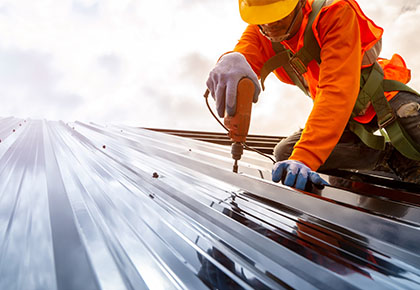Maintenance and Repairs vs. Capital Improvements – What’s the Difference?

Read the Guide
Download our informative guide, Capital Improvements: A Blueprint for Success, to learn the A to Z of capital improvements from experts in the field.
 If you’re on the board of a community association, then you know maintaining your buildings’ assets is not a one-size-fits-all proposition. The common areas require a broad range of routine maintenance and repairs to keep them looking good and operating smoothly. Maintenance activities can include simple lightbulb replacements, housekeeping and paint touch-ups in hallways and garages, landscaping, irrigation repairs, pool cleaning, elevator maintenance, and other related tasks that are performed on an ongoing basis.
If you’re on the board of a community association, then you know maintaining your buildings’ assets is not a one-size-fits-all proposition. The common areas require a broad range of routine maintenance and repairs to keep them looking good and operating smoothly. Maintenance activities can include simple lightbulb replacements, housekeeping and paint touch-ups in hallways and garages, landscaping, irrigation repairs, pool cleaning, elevator maintenance, and other related tasks that are performed on an ongoing basis.And then there are major repairs, replacements, and upgrades, which require larger – and not always planned-for – outlays of time, effort, and expense. Better known as capital expenditures or improvements, these can include big-deal undertakings like carpet replacement, major lighting or landscape projects, pool deck refurbishment, security system upgrades or replacements, exterior painting, painting of garages, stairways, or hallways, and many more.
With such a wide range of maintenance activities and expenses to consider, one thing’s for sure –these cash outlays can’t come out of the same part of your association’s operating budget. That’s why budgets include allocations for both “maintenance” costs and “capital expenditures/improvements.” What’s the difference? In this article, we’ll examine some important facts and considerations.
What is the difference between capital improvement and repair?
Normally, preventive maintenance is classified as repairs that keep your building’s assets in their original condition; these typically fall under Repairs and Maintenance (R&M) in your operating budget. Examples include restoring the asset’s physical condition and operation to a specified standard, preventing further deterioration, replacing, or substituting a component at the end of its “useful life,” or implementing an immediate but temporary repair.On the other hand, capital expenditure and improvements are investments you make to increase the value of your asset. Associations undertake capital improvements when they wish to increase an asset’s useful function or service capacity, perform a required extension of “useful life,” enhance the quality of services, reduce future operating costs, or upgrade essential parts of the asset. These improvements are often designed to last more than a year and usually cost over $10,000.
Examples can include:
- Modernizing elevator cabs
- Installing variable frequency drives on cooling tower motors
- Upgrading to energy-efficient lighting
- Any other significant value-adding improvements
Though simple, the distinction between preventive maintenance and capital improvement is essential – maintenance (R&M) is classified as an expense, while capital expenditure or improvements are typically more expensive and require additional funding options.
Frequently Asked Questions
-
What does “useful life” mean?
“Useful life” refers to an asset’s lifespan – the time that a system or piece of equipment is expected to serve its original purpose. Remember that all your building’s assets (like its security, mechanical and electrical systems) have their own unique, useful lives, spanning a wide range of timeframes. Various factors can affect useful life, such as:
- Wear and tear
- Environmental effects
- Obsolescence (technical or commercial)
- Revised compliance and safety regulations
- And more.
Associations can sometimes extend an asset’s useful life by performing work that improves the design or utilizes better materials than initially included. If your association goes this route, review the expenditure carefully to ensure it is properly classified as either repair and maintenance or a capital improvement. -
Is replacing a roof a capital improvement?
Surprises happen. For instance, a roof leaks, and a roofing company is called to repair it. After an evaluation, the roofing experts determined that the leaky area was beyond repair and that the entire roof needed to be replaced. While a roof repair would have been considered a maintenance expense, the necessary replacement has just become a capital expenditure. -
How do I know if my project is a capital improvement or just a regular repair?
Categorizing an expenditure as either maintenance or as a capital expenditure is a careful decision that should be made each time any maintenance, repair or renovations are performed. To get it right, consider the asset’s value, the intended goal of the work, the scope of work, the actual result and its impact on the asset’s value, depreciation, and equity return.
Consistently and correctly applying the proper expense categorizations can be challenging. Still, it’s worthwhile – and it will go a long way toward ensuring the ongoing financial stability of your association. -
How do community associations fund capital improvement projects?
Most associations include reserve funding in your monthly HOA fees and occasionally include a working capital account that is also funded through the fees. These accounts are responsible for paying for unexpected or large repair items such as new roofing, new gating, etc.
In the case of master-planned communities with individual housing, there is often an HOA capital contribution fee. The HOA capital contribution fee is a one-time payment due upon the sale of an HOA property. The capital contribution is added to the HOA’s reserve account to be utilized for future repairs.
For example, if the HOA needs to repair the security gate or repave the streets, the homeowners association will have enough funds saved in their reserve account.
Furthermore, the capital contribution helps the HOA avoid increasing monthly or quarterly assessments. For most HOA’s, the regular dues paid by each homeowner cover ordinary expenses with some funds saved in reserves.

Download our guide
Read our informative guide, Capital Improvements: A Blueprint for Success to learn the A to Z of capital improvements from experts in the field.